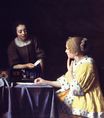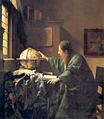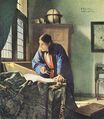Johannes Vermeer - Mistress and Maid. Lady with Her Maidservant Holding a Letter 1666-1667
 |
 |
 |
 |
 |
 |
 |

Mistress and Maid. Lady with Her Maidservant Holding a Letter 1666-1667
90x78cm oil/canvas
Frick Collection, New York City, USA
The image is only being used for informational and educational purposes
<< Previous G a l l e r y Next >>
From Frick Collection, New York City:
Although the subject of writing and receiving letters recurs frequently in Vermeer's work and that of his contemporaries, rarely does it attain the level of dramatic tension so riveting here. Caught in a moment of mysterious crisis, the two women offer us all sorts of scenarios to consider. Class distinctions are easily interpreted: we note the sumptuous garments and jewelry of the mistress, as well as her elaborate coiffure, contrasting so strongly with the simplicity of the maid. Yet, psychologically, we intuit the sharing of private and perhaps illicit information that characterizes the age-old relationship between mistress and maid, and makes them, in a sense, equal. Apart from the drama--and there is often drama in Vermeer's paintings--the pure formal beauty that we associate with his work is present here in abundance, even though the picture appears unfinished. Observe the lack of modeling in the mistress's head and hair (both seem slightly blurred), the paw-like hand of the maid, and the relatively plain brown background. Yet Vermeer seldom if ever surpassed the subtle effects of light seen here. It softly envelops the figure of the mistress in a golden aureole, gleams almost electrically from her pearl jewelry, and sparkles from the glass and silver objects on the table. Bought by Mr. Frick in 1919, the year of his death, this painting was his triumphant last purchase.
From Wikipedia, the free encyclopedia:
Mistress and Maid was painted over the years 1666–1667 on a canvas. The painting shows an elegant mistress and her maid as they look over a love letter that the mistress just received. There are prominent Vermeer styles presented in this painting. There is a strong use of yellow in the woman's elegant fur-lined overcoat, and blue in the silk tablecloth and the maid's apron. The focus of the painting is the two women as they are sitting at a desk, doing an everyday activity. Vermeer was known for his domestic scenes containing women. The light in the painting comes from the left, and falls on the mistress' face, as is apparent from the shadow of the table on her legs. This painting can seem very straightforward at first glance, but it has deeper psychological implications.[according to whom?] If one looks at the image straightforwardly, one sees the mistress as she looks at the sealed love letter, hinting that she has a relationship with someone who is perhaps a great distance away. There is a hinted relationship between the maid and the mistress with their furtive glances and their body language, as they lean towards each other.[citation needed] The mistress has a pensive gaze, with her lips parted ever so slightly and her fingertips lifted to her chin in a questioning manner. The mistress' profile is slightly blurred and undefined and is meant to portray an idea that the woman is soft and sweet. This is likened[by whom?] to another one of Vermeer's paintings, Girl with a Pearl Earring. The painting is preserved well and it has stylistic features such as the large scale of the figures, the dark background, and the dramatic modeling within the scene. In Mistress and Maid, Vermeer played with his medium and created texture and light with his works. For example, the lighted parts of the yellow overcoat are formed with sweeping brushstrokes of lead-tin-yellow and the shadows are created with definition. Dark backgrounds were used in portraiture after Leonardo da Vinci created the trend. They were used because they gave focus to the person in the portrait and enhanced the three-dimensional effect. Vermeer uses dark backgrounds in his other portraits such as Portrait of a Young Woman and Girl with a Pearl Earring. There is a prominent usage of pearls on the mistress in this painting. Pearls were an important status symbol of the period and that was reflected in the mistress' fancy attire and her abundance of pearls. A prevalent theme in Vermeer's paintings from around the late 1660s is letter writings. In earlier works, there is one woman isolated with a letter, but in this painting the added maid is a new element. This gives the painting a sense of anxiousness between the two women over the letter and its potential contents.